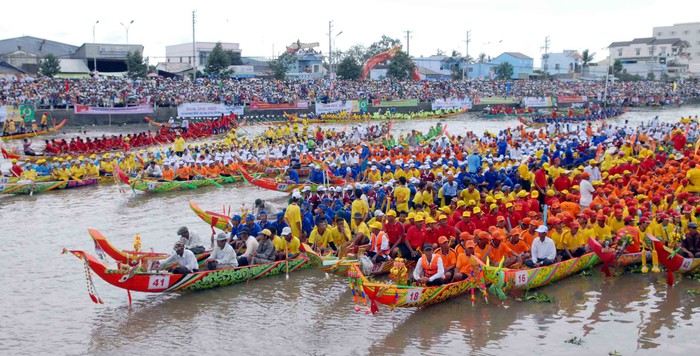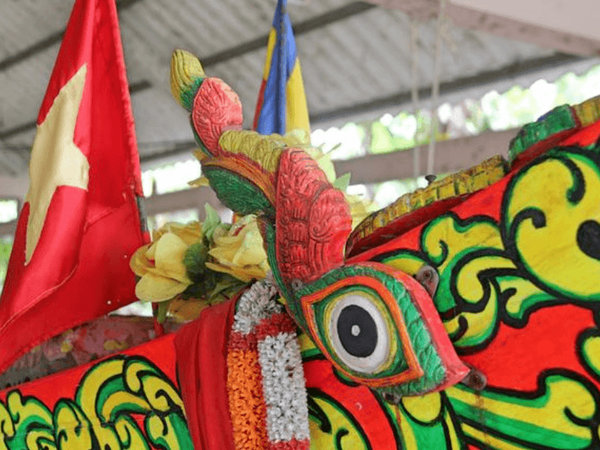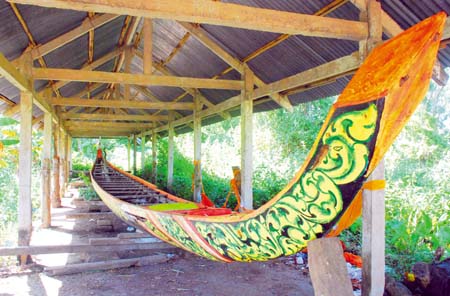
Ghe Ngo (Vietnam)
- Name of sport (game): Ghe Ngo
- Name in native language: Đua Ghe Ngo
- Place of practice (continent, state, nation):
Town of Sóc Trăng in the province Sóc Trăng - Vietnam
- History:
A boat was an important element of the Khmers culture, who used it to navigate the waterway, avoiding wild animals. The waterway also solved the communication issue, as it was difficult to build and maintain roads and bridges in those conditions.
Over time, the boats became faster, which was caused, by tactics during the ethnic war and many conflicts. Tuk Ngo boats were created to escape or quickly attack. Therefore, the boat became an inseparable element of the life of people from these areas, as it was a method of transport used to transfer people and cargo.
There are many legends about the beginnings of the Ngo boat race.
One says that Princess Neng Chanh (Nàng Chanh) disobeyed the will of the king. When he wanted to punish her, she got into the boat and tried to escape by the river. Soldiers, however, caught her and executed on the orders of the king. Every year, a race is organized to memorialize this event.Another story tells about the tradition of bringing Buddhist monks to temples by water, due to the difficulty of travelling by land or danger of wild animals. Initially, first rafts were built from bamboo, then from wood by carving its interior, creating a type of TukNgo boat. With time, rivalry began, who would transport monks faster and for this reason, the tradition of boat racing was born.
According to another legend, the Khmers boat race of Sóc Trăng took place for the first time in Pem Kon Thô, (today Vàm Dù Tho) in the district of Mỹ Xuyên in the province of Sóc Trăng. Ngo boats from Bạc Liêu, Kiên Giang and Trà Vinh congregated in a place where the water flowed calmly and the river was wide to compete with each other. There, Ngo boats from the Bạc Liêu and Kiên Giang regions had a fairly easy task, because the stretch of the river is straight and the water flows calmly. Later, when the region became crowded, intensive commercial traffic appeared, the rivalry moved from Vàm Tho to the Ompuyea River, i.e. Nhu Gia, in the municipality of Thạnh Phú, Mỹ Xuyên District. This theory seems most likely, according to monk Thạch Sô Tưm in his 2009 publication on the Ngo boat race. He adds that the Ngo boat association has existed for a long time (from around 2071 according to the Buddhist calendar, and in 1528 - according to the Gregorian calendar, corresponding to the era of the first king An Chanh) and it was the custom of the inhabitants of the ancient country of Ba Sac (now Sóc Trăng) to organize this type of racing.During the French colonial period, the Khmers were forced to transfer the race to the Om Puie river (that is, the river Nhu Gia today in the municipality of Thạnh Phú, Mỹ Xuyên District, in the province of Soc Trang). However, from time to time (1972–1974) races were organized at Kinh Sáng in the city of Sóc Trăng. After regaining independence, races took place on the Nhu Gia River until the early 1980s. However, due to the scale of the project, the race was officially moved to the Maspéro River (city of Sóc Trăng) in the centre of the capital of the province of Sóc Trăng.
- Description:
Originally, Ghe Ngo was a boat made entirely of a tree trunk, but today finding such large and long trees is difficult, so boards are used. Ghe Ngo has a length of 25 to 30 m, and in the middle, in the widest place, is about 1.1-1.2 m. The boat should resemble a snake, hence the front (head) is raised, but the rear rises even higher (tail). There are 24 to 27 benches for two people along the entire length of the boat. Each boat must provide space for 40 to 60 people (e.g. the Ngo Bốn Mặt (Sóc Trăng) boat could accommodate 53 people in 2013, the Ông Mek boat (Trà Vinh) 57 people).
To strengthen the boat, builders fasten long wooden beams along the central part. Beams must be made of hardwood, usually about 0.2 m in diameter. At the bow of each boat, two eyes are placed to look for the best and safest path. This custom is known in the region, where every boat used for fishing or transport has such signs, and although the Ngo boat is used only for competitions, it also has those eyes.
Each boat has its own symbol, which is a hallmark, allowing the boat to be identified and memorized. Often this symbol is also supposed to show the power of a racing boat and refers to the tradition of each temple. Very often the symbol is animal (e.g. a bird, a tiger, a snake) because they represent power, speed or perseverance. People think that the boat has the power connected with a particular animal. On the entire length, there are patterns and colors referring to the selected symbol. So, if the symbol is a snake, then the motifs on the sides are chosen so that the boat imitates the movement of the snake on the run.
Ngo boats are property of the temples. Each town, for example, a commune and village, has its own temple. Ngo boats are stored inside the temple, cover by a specially prepared roof.
Every activity related to the boat is accompanied by special ceremonies. Starting with the initiation of construction, through launching, ceremonial moving and storage of the boat, everything has its own specific order and ritual. According to the concept of "all spiritual things", the Khmers believe that the Ngo boat is also holy. One of the most important stages is the boat launch ceremony before the race. Not only competitors take part in it, but also the community belonging to the temple (pagoda). Gifts are brought and placed on the mat in front of the boat, and the Master of Ceremonies also burns incense. Everything is accompanied by music, sometimes with specially prepared words for the occasion. Khmers believe that the patron of the Ngo boat is Neng Khmau (Neng Teo), which is why the costumes are often used in the ceremony. When the music ends, the priest kneels before the sacrifices and begins to pray for the favour of the boat. The prayer is repeated three times, and then the boat is symbolically smeared with coconut oil, then the heads of the competitors who promise to unite to win the race are lubricated. When the boat is carried to the river, the procession is accompanied by music.
Because the boat is long and its front and back are bent upwards, it is easy to lose balance and cause overturn. Therefore, before placing the boat on the water, the players train on land to achieve the desired rhythm of work, and above all to learn to synchronize movements. The competitor must be healthy and practice in accordance with the allocated place on the boat. So first, there are exercises on land, then on a wooden platform on a pond or river, and only after mastering the movements and their coordination with the whole team, a trial on the boat is made.
The teams compete in two competitions: Swimming 1200 meters for the male team and 1000 m for the female team. The prize for the men's boat team was 150 million VND in 2017, and 100 million for the women's team (this was the third festival from October 28 - November 3, 2017). - Current status:
Ghe Ngo Boat Racing called The Ngo Sóc Trăng Boat Racing Festival (Đua ghe Ngo Sóc Trăng) are part of the Óc om bóc Festival, which takes place in Sóc Trăng, in the south of Vietnam. During the Festival, many events related to the culture of the Mekong Delta nations are organized, including moon worship ceremony, lamp releasing ceremony, but the most famous and popular part is the boat racing. Since 2013, these races are not only regional but also national competition.
The festival always gathers dozens of Ngo boat teams from around the region that participate in the competition.Originally, the Ngo boat races, on "Oc-Om-peel", were held at Nhu Gia, then at Kinh Xáng - Sóc Trăng Town, and again at Nhu Gia. However, in order to provide the opportunity to watch the race for an increasingly number of spectators in more comfortable conditions, also with the possibility of accommodation, the Ngo boat race was organized in Sóc Trăng. From now on the festival takes place there.
In 2017, 62 teams took part in the race (50 male teams and 12 women's teams), in 2018 there were 51 boat teams (41 male teams and 10 women's teams) from the province of Sóc Trăng, Bạc Liêu, Cà Mau, Hậu Giang, Vĩnh Long. In 2018, nearly 100,000 people from many provinces (e.g. Vĩnh Long, Hậu Giang, Bạc Liêu, Cà Mau) and cities came to Soc Trang to participate in the Festival and watch the Ngo boat races. In 2019, 60 Ngo boats participated in the race.
Boats also participate in international competitions and shows in Cambodia, Singapore, China and Thailand. - Importance (for practitioners, communities etc.):
For Khmers, the boat has many meanings and unique cultural values. Ghe Ngo is not a product of a person or group of people. Each boat is built by people belonging to a specific pagoda and represents it in competition on the water. Therefore, victory or defeat is the triumph or failure of the pagoda and people who belong to the same group.
Spiritual elements are also one of the important factors that help boats succeed.Khmers traditional boat races Ghe Ngo (Đua ghe Ngo Sóc Trăng) Ngo Sóc Trăng Boat Racing Festival are part of one of the major festivals that take place in Sóc Trăng, in the south of Vietnam. The practice of this tradition is testimony to the unique traces of Khmers culture, cultivated for many generations, showing the attachment of the Mekong Delta community to faithful and loyalty to their culture and the joint-life of three ethnic groups: Vietnamese, Khmer and Chinese. Ngo Boat Festival and races are the elements that unite this community and allows to build harmonious relationships between these groups.
The Khmers for a long time have been growing rice. It was not an easy task due to frequent natural disasters, wind, rains or floods. So the "Oc-om-boc" ceremony meant celebrating the rice harvest on lunar days, when the rain and wind cease and the water slowly recedes, starting the dry season after hard days of work. The festival was originally associated with the end of the collection. It was when the Khmers organized a ceremony to show their gratitude for agricultural produce. Although people are very busy with work, they devote their time to training before competitions that are important to them, because they show the culture of the region and allow to cultivate old traditions. Since ancient times, every year, on the day of the full moon of the tenth lunar month in the Khmer calendar, the moon ceremony - Oc - Om - boc is celebrated. This is an important holiday because the moon gives people happiness. It had the character of a family holiday, with a solemn meal, wishes, but also has a social character, because it created an opportunity to have fun and gave a chance for sports competition.
The desire to maintain tradition contributes to supporting social unity and promoting cultural identity through this traditional sport. Tug of war (rope pulling), martial arts and boat races were practiced, but performances were also prepared. Ngo boat races and performing arts are the two most popular elements of this holiday. To take part in the race, boats are renovated, restored, sometimes rebuilt for long months. When the competition day comes, the men and women dressed in festive clothes come to the festival to participate in this unique event, which is the Ngo boat racing.
In addition to the main attraction, which is the Ngo boat race, the festival consists of many different events, including moon worship ceremony, repair of the Ca Mau boat, exhibitions, culinary and sports festivals, competitions, music and dance performances, theatre plays, as well as scientific conferences.
Since 2017, the Ooc Om Boc Festival and the Ngo Soc Trang boat races have been taken care of by the Ministry of Culture, Sport and Tourism of Vietnam (previously the Ngo Boat Racing Festival had a regional character from 2013), which allowed for improving organization and proper preparation competition tracks on the river for Ngo boats. - Sources of information :
Video:
https://www.youtube.com/watch?v=ic8koiMNwVI
https://www.youtube.com/watch?v=5fQAPS3ig-Y
https://www.youtube.com/watch?v=LwGgwwmg0zA
https://www.youtube.com/watch?v=VQ4M_Kidw10 - Gallery:

